That was quite a journey Glenn! Thanks for the ride, I learned quite a bit!
-
Happy Card Playing Day! ♠️♥️♦️♣️🃏
You are using an out of date browser. It may not display this or other websites correctly.
You should upgrade or use an alternative browser.
You should upgrade or use an alternative browser.
Length considerations for a canoe axe: function and safety
- Thread starter Glenn MacGrady
- Start date
You see, that's what I meant about the Best made store, they don't care much about what the tool will be used for, they really only care of what it look like....
Of course, the reason they gave could be BS. It could be Council Tool just trying to save money by cutting down the polishing time.
BTW, thanks for your gentle encouragement for me to keep thinking about the functional value of the Hudson Bay axe head shape. Cutting away the metal to create a beard can save a few ounces, but I now think that shape just compromises chopping power and head attachment strength. If you hit the bottom of that beard, there's an awful lot of leverage trying to pry loose that narrow eye. Maybe the HBA shape was created, as some say, for a trapper to pick up his traps by their chains.
Hmmm . . . I have no power tools, but I suppose I could hand sand the new look Velvicut boys axe to a satin polish. I wonder how long that would take. I have spent a lot of time hand sanding wooden canoe gunwales. But what if I screw up trying to sand metal?
G
Guest
Guest
Hmmm . . . I have no power tools, but I suppose I could hand sand the new look Velvicut boys axe to a satin polish. I wonder how long that would take. I have spent a lot of time hand sanding wooden canoe gunwales. But what if I screw up trying to sand metal?
Do you mean sanding that surface to a polished satin smooth finish by hand? If so I would suggest starting several years ago.
I took the stubborn grunge off the new/old Boys axe with an RO sander, using 120 and then 220 3X grit disks. dang near two full boxes of disks. (I was careful not to get the axe hot or even work too near the cutting edge)
And it still has some embedded black spots to would require too much sanding to relieve. Doing that by hand sanding would have taken….well…I’d probably have given up, but I might have developed arms like Popeye first.
A thought. You have done a lot of research and learned a lot about axe choices. Now you would know what you are looking at if you found an old axe with potential at a yard sale or flea market.
- Joined
- Dec 12, 2014
- Messages
- 364
- Reaction score
- 4
I've MADE MY DECISION as to which is the best axe for my needs, functionally.
I can't tell you how happy I, and perhaps many others in this forum, are to hear this. It's truly great news. Maybe now we can get on to the matter of your injuries as you learn to use the thing.
Philly, I think Glenn was saying he's not going to buy one now. I appreciate Glenn's google-foo, it is second to none, and he has turned up a lot of great info in this thread.
Glenn have you ever done a thread on canoe paddles? Thinking of buying one this year, I've been making them for so long, and have finally realized that although mine are strong, they are often more suited to be axes, as they can cleave and separate things with their great weight.
Glenn have you ever done a thread on canoe paddles? Thinking of buying one this year, I've been making them for so long, and have finally realized that although mine are strong, they are often more suited to be axes, as they can cleave and separate things with their great weight.
- Joined
- Dec 12, 2014
- Messages
- 364
- Reaction score
- 4
Philly, I think Glenn was saying he's not going to buy one now. I appreciate Glenn's google-foo, it is second to none, and he has turned up a lot of great info in this thread.
Glenn have you ever done a thread on canoe paddles? Thinking of buying one this year, I've been making them for so long, and have finally realized that although mine are strong, they are often more suited to be axes, as they can cleave and separate things with their great weight.
Oh, shoot. I didn't read the whole thing. Shame on me; I must have fallen asleep.
This thread is a good example of analysis paralysis - extensive over-thinking and then no action.
Please, let us not have a similar thread on paddles. Or packs. Or French press coffee makers.
- Joined
- Mar 20, 2013
- Messages
- 3,356
- Reaction score
- 972
To bad Philtrum that you didn't get anything out of this thread... And to bad you felt the need to make negative comments... Ho well I guess not every body ses thing the same way, and that is a good thing!!
Cheers
Cheers
Do you mean sanding that surface to a polished satin smooth finish by hand? If so I would suggest starting several years ago.
I took the stubborn grunge off the new/old Boys axe with an RO sander, using 120 and then 220 3X grit disks. dang near two full boxes of disks.
I believe you, but maybe forge scales on a new axe are less stubborn. There are lots of threads on blade forums about how to restore, finish and polish axe heads with sandpaper, wet and dry. Also recommendations to use a canoe (or scythe) stone before sanding. I use a canoe stone to sharpen my machete, though my technique is poor. It does seem, however, that the coarse side of the stone could grind crud off metal.
Here's a video of a guy who bought the standard grade Council Tool Boys Axe, stripped the paint off, and used a grinding wheel to smooth the surface after sanding proved too difficult. After the grinding wheel he then sanded, and it looks darn good. The second half of the video shows how one side of the axe looked before grinding, and the other side after grinding and sanding.
I suspect the modest forge marks on the high end Velvicut Boys Axe should be easier to grind off than what that guy did, but I don't have any grinding wheels or other power equipment. And I don't trust my inexperienced hand technique with my canoe stone.
Once got my husband a Gransfors hatchet for a gift and he loves it. The bigger the axe, the more weight you have to portage. The hatchet does fine for all our canoe tripping needs. Of course we aren't chopping down monster trees. We are carving up dead ones to make campfires. Our old axe was of a different design and took much elbow grease and effort to split wood. In comparison the Gransfors slides through the wood. No, I'm not marketing this thing. Just had good luck with this and wanted to share.
Oh, shoot. I didn't read the whole thing. Shame on me; I must have fallen asleep.
This thread is a good example of analysis paralysis - extensive over-thinking and then no action.
Please, let us not have a similar thread on paddles. Or packs. Or French press coffee makers.
It must be tough keeping your canoe level with that enormous chip on your shoulder. Are you and I going to go down this road again?
Lighten up
What the...! Paint stripper comes in an aerosol can?! Thanks for the vid Glenn. Although the vid feed froze on me, I get the idea of his project. I've been pondering the very same thing. Strip off the ugly factory red paint from my axe head and the slick factory varnish from the handle, and soon wind up with a nicely polished head and (stained?) oiled handle. But, do I want the need to maintain the newly exposed iron, when the paint job is doing that for me now? After your shared researches and some Mears videos, my answer is yes.
Yes I do. And although I've never gotten blisters from a varnished handle, I've also never handled an oiled one either. Anyone have any thoughts on this?
Yes I do. And although I've never gotten blisters from a varnished handle, I've also never handled an oiled one either. Anyone have any thoughts on this?
Last edited:
- Joined
- Jul 25, 2012
- Messages
- 838
- Reaction score
- 22
Hi Brad, A smooth varnished handle will tend to grip you skin, much as cling wrap grips a bowl. The movement of the axe handle is transmitted more directly into your hands and over some time will cause a layer of skin to shear, do it enough and you've got a blister.
A smoothly sanded surface will be more like velvet, allowing a small degree of slip, you can still have hold of your axe, no problem, but the shearing action will be much less. Given that I don't chop all that much, I usually were gloves anyway.
Before you start in on the paint stripper business, give some thought to what it can do to the wood. Caustic chemicals and even just water are things that you don't want to let soak into your axe or work on the steel of the head, especially into the eye. Pretty might have a price you don't want to pay.
No matter what, you've got some exposed steel on the axe head, when I'm done using my axes I clean off any tree juice and sap and if I'm camping use some Vaseline off a cotton ball to coat the steel. When I'm home I'll use paste car wax.
Best Wishes, Rob
A smoothly sanded surface will be more like velvet, allowing a small degree of slip, you can still have hold of your axe, no problem, but the shearing action will be much less. Given that I don't chop all that much, I usually were gloves anyway.
Before you start in on the paint stripper business, give some thought to what it can do to the wood. Caustic chemicals and even just water are things that you don't want to let soak into your axe or work on the steel of the head, especially into the eye. Pretty might have a price you don't want to pay.
No matter what, you've got some exposed steel on the axe head, when I'm done using my axes I clean off any tree juice and sap and if I'm camping use some Vaseline off a cotton ball to coat the steel. When I'm home I'll use paste car wax.
Best Wishes, Rob
And although I've never gotten blisters from a varnished handle, I've also never handled an oiled one either. Anyone have any thoughts on this?
A lot of paddlers feel the same way about varnish on the grips and shafts of wooden canoe paddles: they don't like varnish. I typically like an unvarnished grip but don't mind it on the shaft. Greenland paddle makers and users typically prefer boiled linseed oil (BLO) or tung oil on their paddles because they slide their hands over all surfaces during sophisticated moves. I've used Watco oil on paddle grips, but that has a little varnish in it.
I can confidently say from reading lots of axe forums that the preferred treatment for axe handles is several applications of BLO or sometimes tung oil. Many users follow that up with an application of beeswax. There are even formulations of beeswax called "axe wax".
To expand the wood inside the eye, some people soak the head in BLO or machine oil periodically. The metal head on the axe itself is protected by machine oil or some kind of wax.
- Joined
- Mar 20, 2013
- Messages
- 3,356
- Reaction score
- 972
Also, oiled handle(paddle shaft) tend to be less slippery when wet or frosty.... I like oil my self, and on the paddle I make, most are oiled for the shaft, always on the grip. If I varnish the shaft, I usually go over it with 0000 steel wool to make it a bit more "velvety"...
Well, I'll steal Glenn's thunder and tell everyone that I .......ordered an axe last night, on-line. I'm not telling what it is either, but will give a review when I receive it and get to use it.
Well, I'll steal Glenn's thunder and tell everyone that I .......ordered an axe last night, on-line. I'm not telling what it is either, but will give a review when I receive it and get to use it.
Can't wait to hear how you like your new Vipukirves!
Looking forward to seeing what Glenn talks you into buying next.
Alan
Can't wait to hear how you like your new Vipukirves!
Alan
Once again you do Iowa proud.
- Joined
- Dec 12, 2014
- Messages
- 364
- Reaction score
- 4
To bad Philtrum that you didn't get anything out of this thread... And to bad you felt the need to make negative comments... Ho well I guess not every body ses thing the same way, and that is a good thing!!
Cheers
OMG ... my apologies. I meant that over-analysis comment strictly intellectually and quite literally, nothing else intended. I see now that it could easily be taken as offensive. I'm sorry, Glenn, if I offended you, and everyone else if I clouded over the otherwise happy tone on this forum.
I just realized that I posted a lot of "Boys Axe" pictures in Mike McCrea's "New Axe Project" thread, so let me summarize why I decided, after all this research, that a Boys Axe is the best single axe for my particular needs.
I started out wanting a packable-portagable canoe axe that could be used for light felling and chopping, limbing and firewood splitting while canoe camping. But I then changed my mind a little to give more weight to felling and chopping. That's because I suspect I'll begin to use this one-and-only axe on my 11 acres at home, which is exactly what happened to me when I got my first (of now three) tractors, chainsaw and machete.
I decided that an effective length of 24"-27" would be the best -- a so-called 3/4 axe, which are sometimes falsely listed at 28" before they are cut down during handle hanging.
I then decided on a head weight range of 1.75 lbs. to 2.3 lbs.
Within these length and head weight targets, I began my journey heavily favoring the Hudson Bay Axe (HBA) shape for aesthetic and historical reasons and also because it's convenient to get your hand high up behind the blade for fine carving tasks. For these summary purposes, I consider the "3/4 Scandinavian axes" from Gransfors Bruks, Wetterlings and Hultafors (Husqvarna) essentially to be modified HBA shapes.
I then traveled to stores to actually hold HBA axes with 2.0 lb. heads. They happened to be older Collins axes. I decided that these axes were a little too lightweight for the slightly enhanced chopping and felling capability I was after. I'm sure all of these ~2.0 lb. head HBA and Scandinavian axes would suit my needs just fine for canoe tripping, but I wanted just a little more chopping heft for home use.
I also became less enamored of the HBA head pattern, with its long beard and cutaway blade. There are lots of credible reports that these heads loosen easier than just about any other axe head pattern. I also decided that "hand carvability" with an axe was not a high priority for me with this tool. I now have three fixed blade knives for carving as well as several quality folders.
That led me to the Boys Axe, which I had been ignoring, but which has been used by the US Forest Service as their 3/4 axe for at least 100 years. It typically has a 2.25 lb. head. Many reports and videos show that these slightly heavier and slightly cheekier Boys Axes can fell and split more easily than the three lighter Scandinavian Axes. There are lots of inexpensive Boys Axes in hardware stores, mostly from China and Mexico if that matters to you. It does to me. I prefer Made in the USA.
All these learning experiences led me to the Council Tools Boys Axe, which comes in three increasing grades of steel, finish and price: standard grade, Forest Service grade head with Velvicut handle (only available from Omaha Knife, which will also sharpen them), and the full Velvicut grade. The Velvicuts all used to be a polished satin finish, but for the past six months have come with unpolished forge markings (but not with a black coating like the Scandinavian axes). The change in finish greatly disappoints my aesthetic preference, but doesn't affect axe function.
Here is the Council Forest Service edition in between a Husqvarna (Hultafors or Wetterlings) Forest Axe and a Gransfors Bruks Scandinavian Forest Axe. The head is clearly heavier and the Velvicut handle is slimmer than the Scaninavians, which can be seen better in a later photo below.
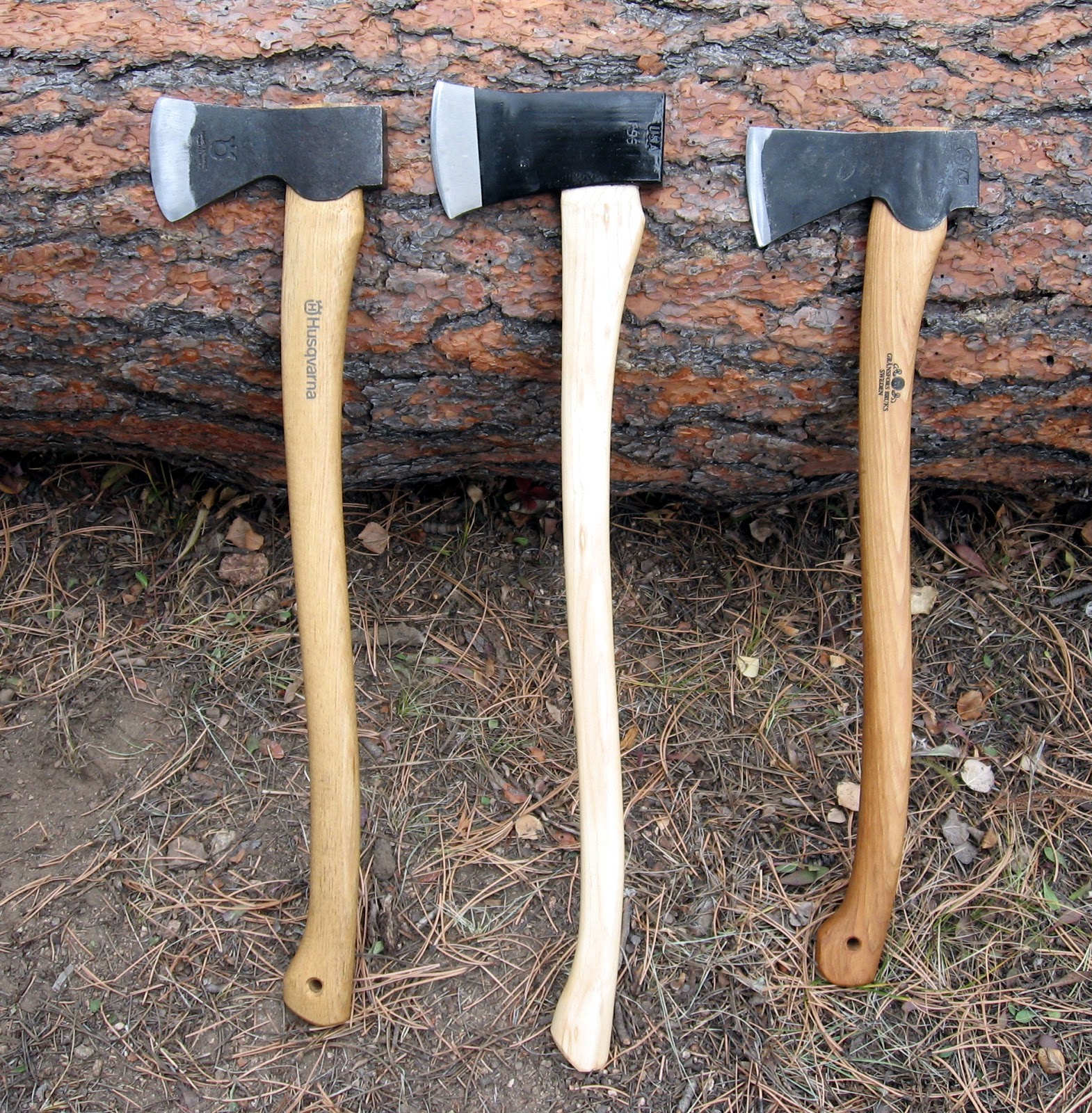
Yet, the CT Boys Axe (middle) has a fairly fine edge compared to the Wetterlings on the left and GB on the right. But it thickens up more than the GB near the eye to help splitting. (The CT FSS version has a plastic wedge in the eye, per FS specs.)
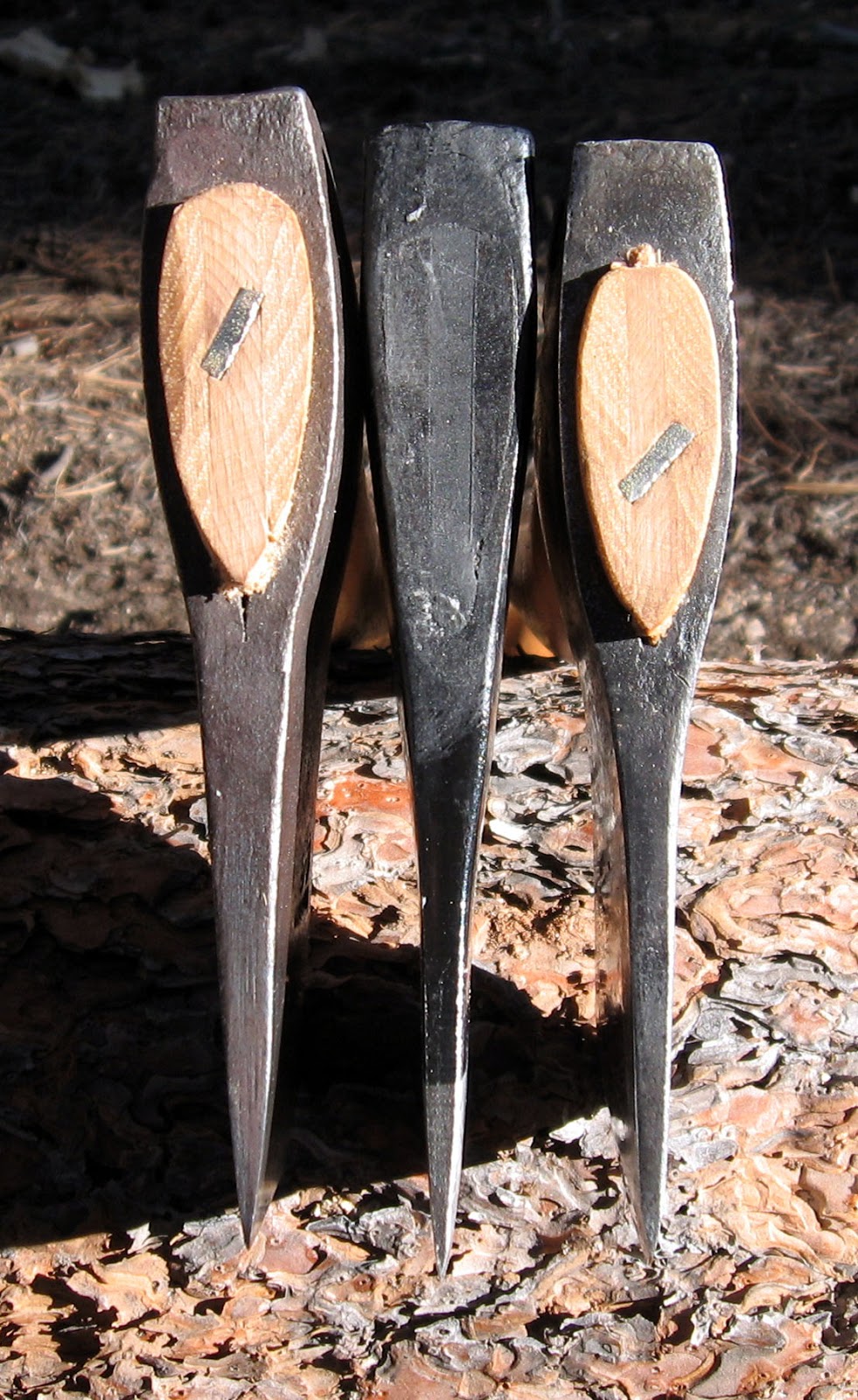
The CT Velvicut Boys Axe is sort of hollow ground from above the convex edge to the splitting swell.
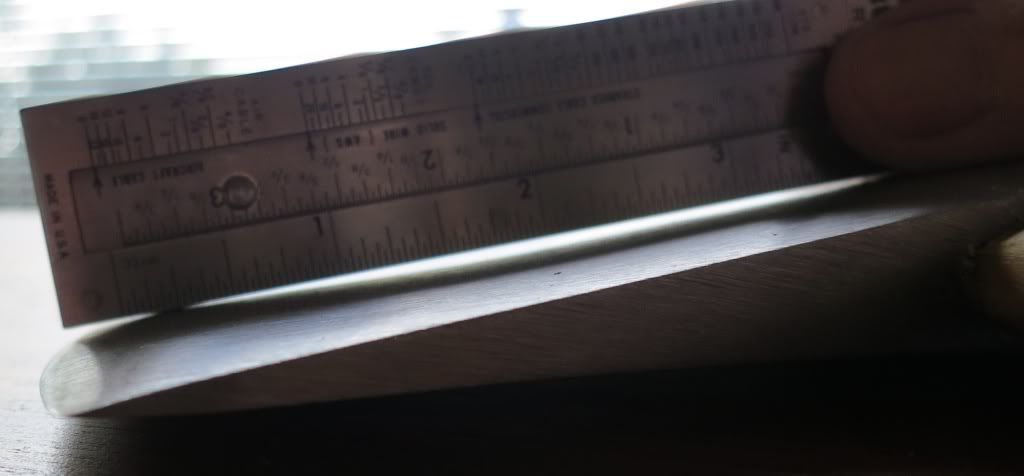
It's convex along the blade from left to right so the center of the blade is thicker, which helps prevent sticking in wood.
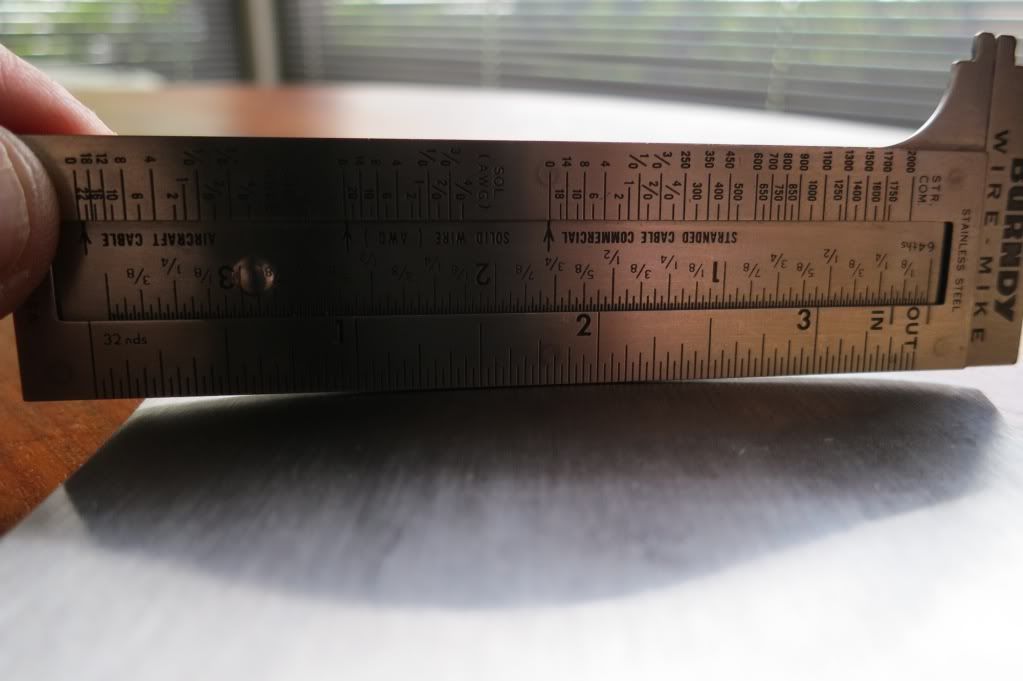
The handle is thinner than the GB Scandinavian Forest Axe (on left).
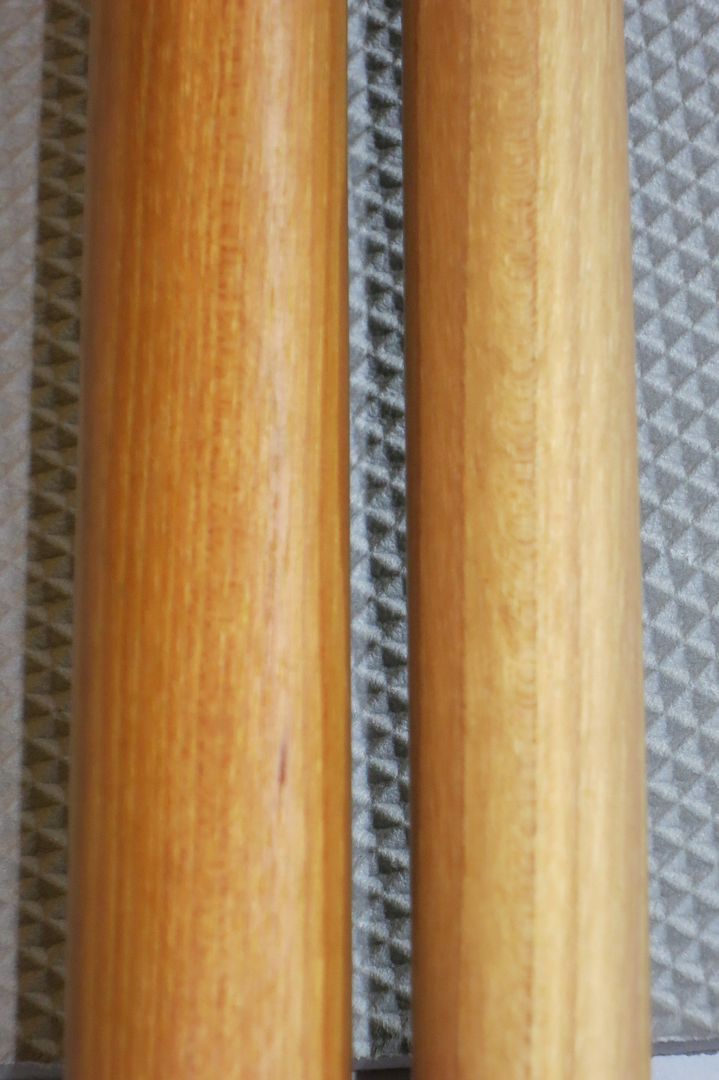
Here is the sheath that comes with the CT Velvicut.

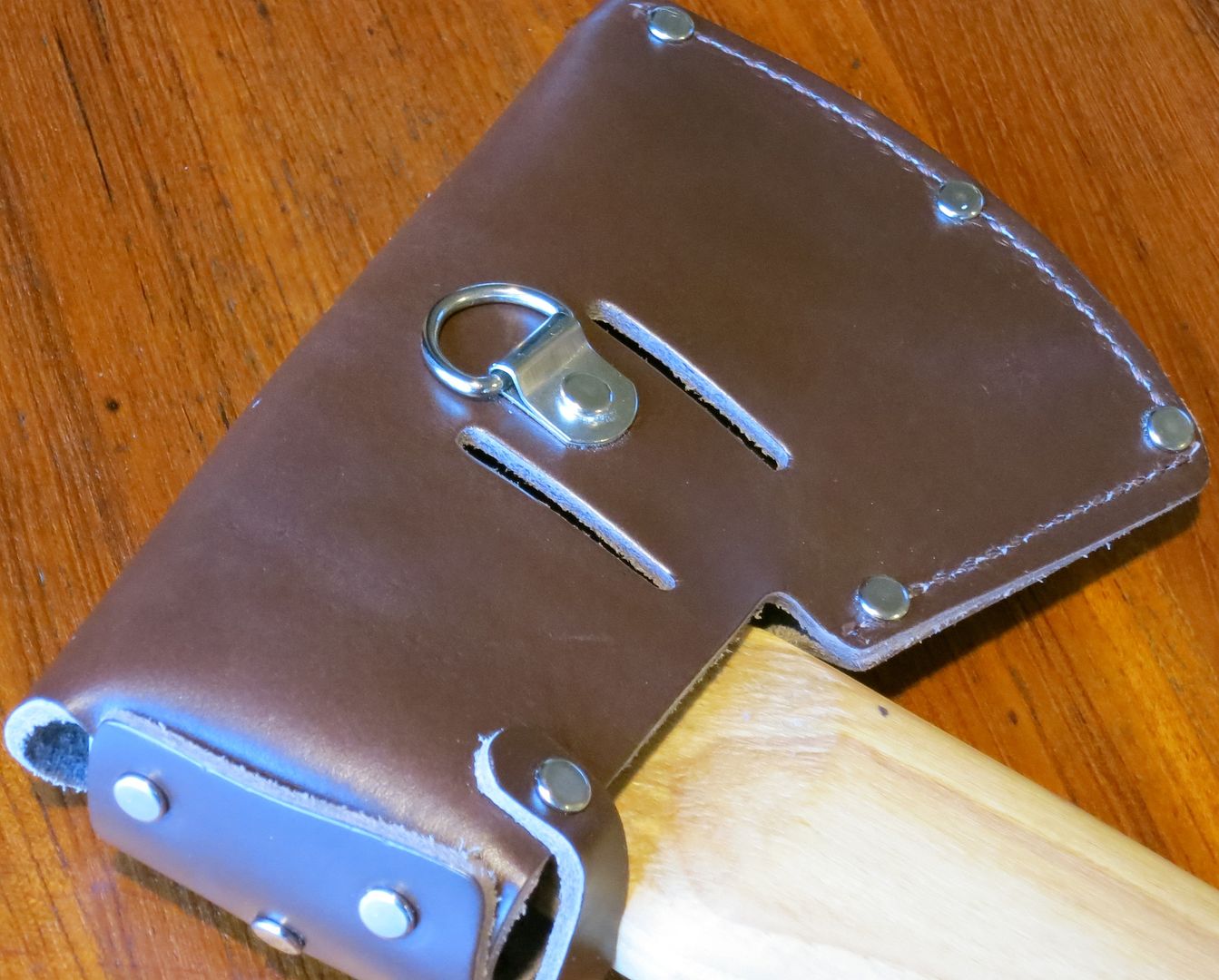
Again, I came to realize that I wanted a "compromise" axe for canoe tripping and light property clean-up. I don't want to buy and own multiple axes, which I suspect is the case for many of the advice givers here and, most very especially, on axe and bushcraft forums.
(I've just been on the phone with Zoro. They have a risk-free 30 day return policy, even if you use the tool, and they pay the return postage. Hmmmm . . . $98 for a Council Tool Velvicut Boys Axe, with an expiring 20% off coupon, for an axe with a $140 MSRP. Hmmmm . . . .)
I started out wanting a packable-portagable canoe axe that could be used for light felling and chopping, limbing and firewood splitting while canoe camping. But I then changed my mind a little to give more weight to felling and chopping. That's because I suspect I'll begin to use this one-and-only axe on my 11 acres at home, which is exactly what happened to me when I got my first (of now three) tractors, chainsaw and machete.
I decided that an effective length of 24"-27" would be the best -- a so-called 3/4 axe, which are sometimes falsely listed at 28" before they are cut down during handle hanging.
I then decided on a head weight range of 1.75 lbs. to 2.3 lbs.
Within these length and head weight targets, I began my journey heavily favoring the Hudson Bay Axe (HBA) shape for aesthetic and historical reasons and also because it's convenient to get your hand high up behind the blade for fine carving tasks. For these summary purposes, I consider the "3/4 Scandinavian axes" from Gransfors Bruks, Wetterlings and Hultafors (Husqvarna) essentially to be modified HBA shapes.
I then traveled to stores to actually hold HBA axes with 2.0 lb. heads. They happened to be older Collins axes. I decided that these axes were a little too lightweight for the slightly enhanced chopping and felling capability I was after. I'm sure all of these ~2.0 lb. head HBA and Scandinavian axes would suit my needs just fine for canoe tripping, but I wanted just a little more chopping heft for home use.
I also became less enamored of the HBA head pattern, with its long beard and cutaway blade. There are lots of credible reports that these heads loosen easier than just about any other axe head pattern. I also decided that "hand carvability" with an axe was not a high priority for me with this tool. I now have three fixed blade knives for carving as well as several quality folders.
That led me to the Boys Axe, which I had been ignoring, but which has been used by the US Forest Service as their 3/4 axe for at least 100 years. It typically has a 2.25 lb. head. Many reports and videos show that these slightly heavier and slightly cheekier Boys Axes can fell and split more easily than the three lighter Scandinavian Axes. There are lots of inexpensive Boys Axes in hardware stores, mostly from China and Mexico if that matters to you. It does to me. I prefer Made in the USA.
All these learning experiences led me to the Council Tools Boys Axe, which comes in three increasing grades of steel, finish and price: standard grade, Forest Service grade head with Velvicut handle (only available from Omaha Knife, which will also sharpen them), and the full Velvicut grade. The Velvicuts all used to be a polished satin finish, but for the past six months have come with unpolished forge markings (but not with a black coating like the Scandinavian axes). The change in finish greatly disappoints my aesthetic preference, but doesn't affect axe function.
Here is the Council Forest Service edition in between a Husqvarna (Hultafors or Wetterlings) Forest Axe and a Gransfors Bruks Scandinavian Forest Axe. The head is clearly heavier and the Velvicut handle is slimmer than the Scaninavians, which can be seen better in a later photo below.
Yet, the CT Boys Axe (middle) has a fairly fine edge compared to the Wetterlings on the left and GB on the right. But it thickens up more than the GB near the eye to help splitting. (The CT FSS version has a plastic wedge in the eye, per FS specs.)
The CT Velvicut Boys Axe is sort of hollow ground from above the convex edge to the splitting swell.

It's convex along the blade from left to right so the center of the blade is thicker, which helps prevent sticking in wood.

The handle is thinner than the GB Scandinavian Forest Axe (on left).

Here is the sheath that comes with the CT Velvicut.


Again, I came to realize that I wanted a "compromise" axe for canoe tripping and light property clean-up. I don't want to buy and own multiple axes, which I suspect is the case for many of the advice givers here and, most very especially, on axe and bushcraft forums.
(I've just been on the phone with Zoro. They have a risk-free 30 day return policy, even if you use the tool, and they pay the return postage. Hmmmm . . . $98 for a Council Tool Velvicut Boys Axe, with an expiring 20% off coupon, for an axe with a $140 MSRP. Hmmmm . . . .)
Last edited:
Buy one, then we can compare axes, I hope mine's bigger than yours!
Similar threads
- Replies
- 22
- Views
- 2K
- Replies
- 10
- Views
- 937
